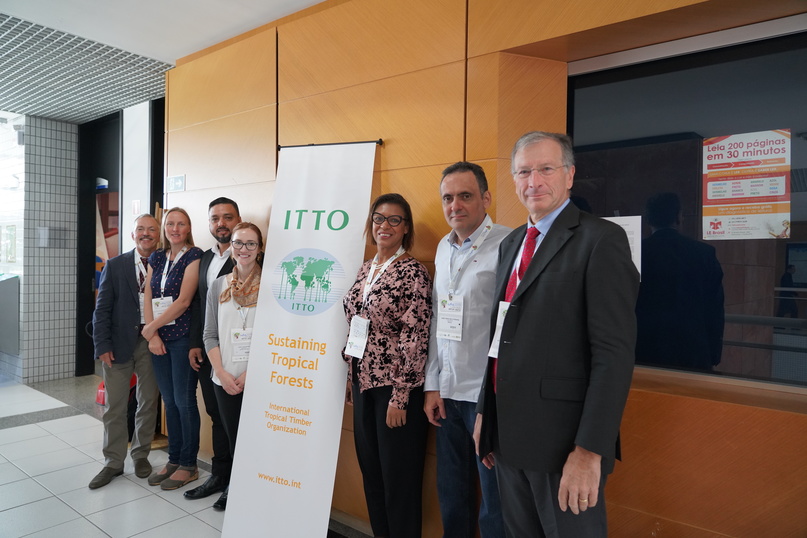Legal, sustainable value chains important for SDGs, say experts at IUFRO World Congress
9 October 2019, Yokohama, Japan

Speakers and moderator at ITTO’s technical session at the XXV IUFRO World Congress. From left: Steven Johnson (moderator), ITTO; Andrea Olbrich, Thünen Institute; Francisco Cadavid, MiAmbiente; Cady Lancaster, USFS; Thais Linhares-Juvenal, FAO; Francisco Pereira, EMBRAPA; and Gerhard Dieterle, ITTO. Photo: R. Carrillo/ITTO
Speakers at the technical session, Global green supply chains as a driver for sustainable forest management in the tropics, presented on research and recent experiences at various links of the wood supply chain that exemplified the potential for markets to become drivers of sustainable forest management (SFM).
Opening the session, ITTO Executive Director Dr Gerhard Dieterle spoke about various aspects of the legality, sustainability and profitability of tropical timber supply chains. Building legal and sustainable supply chains, he said, requires commitments and actions across a wide spectrum of stakeholders, who need to interact in a coordinated manner to ensure sustainable and legal production.
“Most tropical timber-producing countries have the will to establish green supply chains, but they lack sufficient infrastructure and technology,” said Dr Dieterle. “Capacity building, incentives, financing, access to information and data, rule of law and strengthened dialogue and cooperation among producers, buyers, processors and markets at national and international levels would increase the viability of the supply chains.”
Dr Dieterle also noted that the latest report of the Intergovernmental Panel on Climate Change highlighted the role of forests and wood products as a means for moving towards a bioeconomy, mitigating climate change and achieving the SDGs.
In her presentation, Thais Linhares-Juvenal, Team Leader on Forest Governance and Economics at the Food and Agriculture Organization of the United Nations (FAO), noted that recent assessments have examined the contributions of forests to poverty alleviation, food security, women’s empowerment, life on land, climate action, clean energy and innovation. Wood value chains have the potential to increase forest conservation, contribute to climate-change mitigation and achieve several SDGs.
Ms Linhares-Juvenal spoke of a “basket-of-value-chains” approach, which could obtain synergies and enable trade-offs for landholders and others among the many ecosystem services and wood and non-wood products produced by forests and trees. In a dynamic system, the sustainability of such baskets can best be achieved when all potential value chains are developed within their potential and does not prevent the existence of the other.
Other presentations looked at technological innovations designed to assist the development of legal and sustainable forest value chains.
Francisco Pereira, a researcher at the Brazilian Agricultural Research Corporation (EMBRAPA), presented a software tool best known as “BoManejo” that is assisting in the formulation, approval and implementation of SFM plans, which are required by law in the Brazilian Amazon.
BoManejo is a platform for making knowledge and new technologies easily available and potentially incorporated into SFM across the Amazon. For example, it can be integrated into the systems of government regulatory agencies for the authorization of log transportation; it can also be used to generate operational and licensing maps, locate the position of trees to be harvested and retained, and monitor the progress of harvesting operations. BoManejo is an output of an ITTO-financed project executed by EMBRAPA.
According to Cady Lancaster at the US Forest Service International Programs (USFS IP), one of many considerations for screening timber import declarations is determining whether shipments contain a mix of species. She said that the USFS IP’s Wood Identification and Screening Center (WISC) has developed a screening protocol using fluorescence to identify probable inconsistencies in species declarations for finished products when multiple species are suspected. Many timber species have a native fluorescence that can easily be observed with exposure to 365 nm light, and this phenomenon is used in species identification in traditional wood anatomy. The detection of inconsistent fluorescence responses can be used to efficiently target shipments for more advanced forensic identification. Ms Lancaster said that the WISC is developing a visual database of wood fluorescence for high- and low-risk species. The protocol is now assisting frontline customs officers in carrying out their jobs efficiently.
Mr Victor Francisco Cadavid, Forestry Director at Panama’s Ministry of Environment (MiAmbiente), showcased a timber-tracking system piloted in Darien Province, Panama, which has already improved forest governance, reduced illegality and brought benefits to forest managers, timber companies, the government and forests. The system tracks trees using electronic devices—chips—from the moment they are identified in annual operating plans to the point at which the timber reaches the market. According to a video presented at the session, the system collected information on around 700 crop trees per day in its pilot phase, and the Ministry of Environment is planning to expand its use to other regions of the country. The tracking system is an output of an ITTO-financed project executed by WWF-Panama in collaboration with MiAmbiente.
Andrea Olbrich from the Thünen Institute in Hamburg, Germany, presented on technologies for verifying the origins, species and genera of wood and wood products. Since the entry into force of several pieces of legislation aimed at keeping illegal timber out of markets, species identification and the verification of origin have become increasingly important for many kinds of wood products. The Thünen Centre of Competence on the Origin of Timber conducts verification of origin for several government agencies, timber trade bodies, consumers and associations.
Ms Olbrich explained some of the difficulties associated with timber identification for pulp, paper and fibreboard because of a lack of suitable reference material for Asian hardwoods. The Thünen Institute has now analyzed 38 species or species groups (including a bamboo and a palm) and published references for them; therefore, these timbers can now be identified in pulp, paper and fibreboard.
A wide-ranging discussion among panelists and inputs from the floor indicated a consensus that a strong scientific basis was needed for the development and management of productive forests and their associated value chains as an important means for meeting global challenges.
Download the presentations